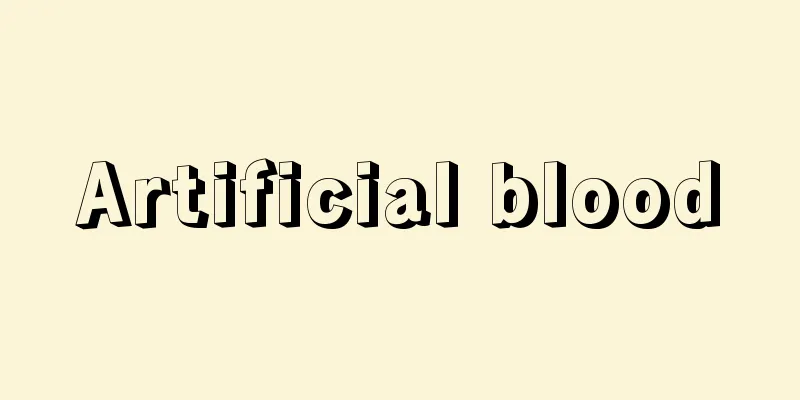Artificial blood

|
An artificial substance that has the oxygen-carrying ability of red blood cells, has no blood type, and can be stored for a long time. Blood is composed of blood cells and plasma. Among the blood cells are white blood cells, which play a role in the defense of the body by phagocytosing and processing bacteria and foreign bodies, and by providing immune functions (which are divided into those mediated by the production of immunoglobulins and those that act directly on cells). There are also platelets, which help stop bleeding at the site of bleeding. Red blood cells make up the majority of blood cells, and are responsible for transporting and supplying oxygen to tissues and organs and for transporting carbon dioxide. Artificial blood is a preparation that is the subject of research and development primarily as a replacement for red blood cells. [Kenji Ikebuchi] Advantages of artificial bloodNormally, when red blood cells are transfused, they must have the same blood type (ABO type, RhD type) as the patient, and there must be no agglutination reaction between the patient's red blood cells and serum and the transfusion product, i.e., they must be compatible, and testing is always required before transfusion. In emergencies, there are often cases where there is no time to perform this testing. Artificial blood has blood type substances removed during the manufacturing process, so it can be used quickly without testing. In addition, since red blood cell products are derived from living organisms, there is a very small risk of transmitting infectious diseases such as viruses and bacteria through transfusion. Artificial blood is safe because the manufacturing process includes inactivation and removal processes for viruses and bacteria. In addition, red blood cell products are alive, so their storage period is limited to 21 days at 4°C, but artificial red blood cells currently under development can be stored at room temperature for more than two years and their functionality is guaranteed. [Kenji Ikebuchi] PerfluorocarbonThe first formulation developed as artificial red blood cells was perfluorocarbon (PFC). PFC is a carbon compound with high oxygen dissolving capacity, but because it is insoluble in water, it is suspended in a surfactant and formulated. Its particle size is extremely small compared to red blood cells, and it can transport oxygen to ischemic lesions (areas where the inflow of arterial blood is reduced or cut off) where red blood cells cannot normally circulate. However, when administered in large quantities as a substitute for red blood cells, it is known to be captured by the reticuloendothelial system, which is responsible for processing foreign bodies in the liver, spleen, and bone marrow, affecting the function of those organs, and various attempts are being made to improve its physical properties. [Kenji Ikebuchi] Hemoglobin preparationsHemoglobin, which carries oxygen, is purified from red blood cells, and preparations have been developed that are molecularly designed to stabilize the molecule and extend its lifespan within blood vessels after administration. New hemoglobin products include intramolecular crosslinking, intermolecular crosslinking, and polymer-linked hemoglobin with larger molecular weight, as well as genetically modified hemoglobin that has been genetically modified to increase oxygen-carrying capacity. Oxygen-carrying capacity is fully guaranteed. However, due to its small molecular size, it takes up nitric oxide, a vascular smooth muscle relaxing factor produced by vascular endothelial cells, with high affinity, resulting in blood vessels being in a sustained state of constriction. This causes side effects such as elevated blood pressure. There are issues that need to be resolved before it can be used clinically in humans. [Kenji Ikebuchi] Liposome-encapsulated hemoglobinA formulation is currently in the development stage, in which purified hemoglobin is encapsulated in liposomes, which are lipid bilayer vesicles with the same structure as cell membranes. Concentrated hemoglobin molecules and an allosteric factor that regulates oxygen affinity are simultaneously encapsulated in liposomes of approximately 250 nanometers, and the surface is modified with polyethylene glycol, resulting in high oxygen transport capacity and biocompatibility. Although still at the animal experimental level, it has been reported that animals can survive when 40% of their blood is replaced with this formulation, and that blood pressure can be maintained by administering this formulation even during bleeding of 90% or more. A manufacturing plant is currently being planned with human clinical application in mind. Other artificial bloodAn albumin-heme complex, which combines human serum albumin with a synthetic heme derivative, has the ability to transport oxygen and is currently being developed domestically. Platelet substitutes are also being developed, and a preparation is in the development stage in which the platelet-specific glycoproteins responsible for platelet functions (adhesion, aggregation, etc.) are immobilized on the surface of liposomes or polymerized albumin in a large molecule. [Kenji Ikebuchi] [References] | | | | | |Source: Shogakukan Encyclopedia Nipponica About Encyclopedia Nipponica Information | Legend |
|
赤血球のもつ酸素運搬能を有し血液型をもたず長期保存できる人工物。血液は血球成分と血漿(けっしょう)成分で構成される。血球成分の中には白血球があり、細菌や異物などを貪食(どんしょく)して処理する機能や免疫機能(免疫グロブリンの産生を介するものと細胞が直接働くものに分かれる)を介して生体防御を担っている。また出血部位の止血に働く血小板もある。赤血球は血球成分の大部分を占め、組織や臓器へ酸素を運搬・供給し炭酸ガス(二酸化炭素)を搬出する役割を担っている。人工血液とは、主としてこの赤血球にかわるものとして開発研究の対象になっている製剤である。 [池淵研二] 人工血液の利点通常は赤血球を輸血する場合、患者と同じ血液型(ABO型、RhD型)であることと、患者の赤血球および血清と輸血製剤間で凝集反応が生じないこと、すなわち適合していることが必要であり、輸血前にはかならず検査が求められる。緊急時にはこの検査を行うだけの余裕がないケースも往々に発生する。人工血液は製造工程で血液型物質が除去されており、検査をせずに迅速に使用できる。また赤血球製剤は生物由来であるため、ごくわずかなチャンスではあるものの輸血を介してウイルスや細菌など感染症を伝播(でんぱ)するリスクを抱えている。人工血液では製造工程にウイルスと細菌に対する不活化および除去工程が組み込まれており安全である。また赤血球製剤は生きているため保存期間が4℃で21日間と限られているが、現在開発が進んでいる人工赤血球は室温で2年以上保存できて機能が保証されている。 [池淵研二] パーフルオロカーボン最初に人工赤血球として開発された製剤はパーフルオロカーボン(PFC)である。PFCは高い酸素溶解能をもつ炭素化合物であり、水に溶けないため界面活性剤を用いて懸濁させ製剤化する。粒径が赤血球に比べ極端に小さく、通常では赤血球が循環できない虚血病巣(動脈血の流入が減少あるいは途絶している部分)にも酸素を運搬できる。ただし赤血球の代替として大量に投与された場合、肝臓、脾臓(ひぞう)、骨髄などで異物処理を担当する網内系に捕捉(ほそく)され、その臓器の機能に影響を及ぼすことが知られ、種々の物性改良が試みられている。 [池淵研二] ヘモグロビン製剤酸素を運搬するヘモグロビンを赤血球から精製し、分子の安定性および投与した後の血管内寿命を延長させるための分子設計を施した製剤が開発されている。ヘモグロビン分子内の架橋、分子間の架橋、高分子を結合させ分子量を大型化したもの、あるいは酸素運搬能を高めるように遺伝子を改変して製造した遺伝子組換えヘモグロビンなどが登場している。酸素運搬能は十分保証されている。ただし分子サイズが小さく、血管内皮細胞が産生する血管平滑筋弛緩(しかん)因子である一酸化窒素を高い親和性で取り込んでしまい、結果として血管が持続的に収縮した状態になる。これが原因で血圧上昇など副作用が惹起(じゃっき)される。ヒトへの臨床応用には解決すべき課題を抱えている。 [池淵研二] リポソーム内包型ヘモグロビン細胞膜と同じ構造をもつ脂質二重膜小胞のリポソーム内に精製したヘモグロビンを内包させた製剤が開発段階にある。濃縮したヘモグロビン分子と酸素親和度を調節するアロステリック因子を同時に約250ナノメートルのリポソームに内包させ、表面をポリエチレングリコールで修飾しており、酸素運搬能および生体適合性は高い。動物実験レベルであるが40%の血液を本製剤で置換しても動物が生存できることや、90%以上の出血時でも本製剤の投与で血圧が維持できることが報告されている。ヒトへの臨床応用を念頭にした製造プラントが計画中である。 その他の人工血液ヒト血清アルブミンと合成ヘム誘導体を組み合わせたアルブミン‐ヘム複合体に酸素運搬能があり国内で開発研究が行われている。血小板の代替物も開発が進められており、リポソームや巨大分子化した重合アルブミンの表面に、血小板機能(接着や凝集など)を担う血小板固有の糖タンパク(グリコプロテイン)を固相化させた製剤が開発段階にある。 [池淵研二] [参照項目] | | | | | |出典 小学館 日本大百科全書(ニッポニカ)日本大百科全書(ニッポニカ)について 情報 | 凡例 |
<<: Artificial blood vessel graft; vascular prostheses
Recommend
Tongue cancer - carcinoma of the tongue
This is a carcinoma that occurs in the tongue, and...
Oomura - Ooomuro
…A Shingon Buddhist monk in the mid-Heian period....
Telegraph pole - denshinbashira
〘noun〙① A pole that supports telegraph, telephone,...
Nationalism
In a broad sense, it refers to the idea of emph...
Ordos style bronze sword
⇒ Ordos style dagger Source: About Shogakukan Digi...
Adone - Adone
…Petrarch had already been awarded the title of p...
Singspiel - Singspiel (English spelling) German
It means "musical drama." It is a type ...
Siraya
...In general, there are few linguistic documents...
Hemerocallis flava (English spelling) Hemerocallisflava
… [Mitsuru Hotta]... *Some of the terminology tha...
Lampetra tridentata (English spelling) Lampetra tridentata
…[Toru Taniuchi]. … *Some of the terminology that...
Nadelman, E.
...Around the end of the 19th century, academic n...
Alaska Railroad
...There are many glaciers. The Alaska Railroad r...
Good harvest - Housaku
〘 noun 〙 A large harvest of agricultural products....
History of Ireland - Ireland
...In other words, it is a movement that emphasiz...
Cataldi, PA - Cataldi
…This is called the Lucas criterion and is a powe...









